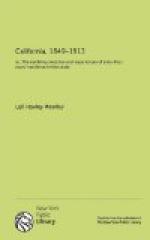The next three hundred miles were devoid of any especial interest. This brings us to the summit of the Rocky Mountains (at South Pass) which divides the rivers of the Atlantic and Pacific Oceans, and ends their course thousands of miles apart. Here are the ever snow-capped peaks of the Wind River Mountains looming up on the north. They are conical in form and their base is about one thousand feet above the plain that extends south. This brings us to the nineteenth day of July, 1849. On the night of this day water froze to the thickness of one-fourth of an inch in our buckets. The following day we commenced descending the western slope, which was very rapid and rough. The twenty-first brought us to Green River which was swollen and appeared to be a great barrier. Here, for the first time, we brought our pontoons into use and swam the mules, so that after two days of hard work we were all safely landed on the west bank. We are now at the base of the Rocky Mountains on the west, passing from one small valley to another, until we reached a bend in the Bear River. Here let us pause for a moment and study the wonders of nature.
First, the ground all around is covered with sulphur; here, a spring of cold soda water; there, a spring of hot soda water; fourth, an oblong hole about four by six inches in the rocky bank, from which spouts hot soda water, like the spouting of a whale. It is called “Steamboat Spring.” It recedes and spouts about once in two minutes. All of these are within a hundred steps of each other.
Now, our canteens, and every available vessel is to be filled with water, for use in crossing forty-five miles of lava bed, where there is neither water nor grass to be found and must be accomplished by traveling day and night. This was called “Subletts’ Cutoff,” leaving Salt Lake to the south of us, and brings us to the base of the mountains at the source of the Humboldt River.
On the west side, in crossing over, we encountered a place in a gorge of the mountain called “Slippery Ford,” now called the “Devil’s Half-Acre.” It was a smooth inclined surface of the rock and it was impossible for the mules to keep their footing. We had great difficulty in getting over it.
Now we are at the headwaters of the Humboldt River, along which we traveled for three hundred miles, over an alkali and sandy soil until we came to a place where it disappeared. This was called the “Sink of the Humboldt.” This valley is twenty miles wide by about three hundred long. During this part of our journey there was nothing of interest to note. The water of this river is strongly impregnated with alkali.
About forty miles in a southerly direction from the sink of the Humboldt (now called the Lake) is old “Ragtown” on the banks of the Carson River, not far from Fort Churchill. In traveling from one river to the other there was no water for man or beast. When we were about half way we found a well that was as salt as the ocean. We reached this well sometime in the night of the first day and our mules were completely fagged out, so we left the wagons, turned the mules loose, and drove them through to the Carson, arriving there on the night of the second day. Here was good grass and fine water, and bathing was appreciated to its fullest extent.




